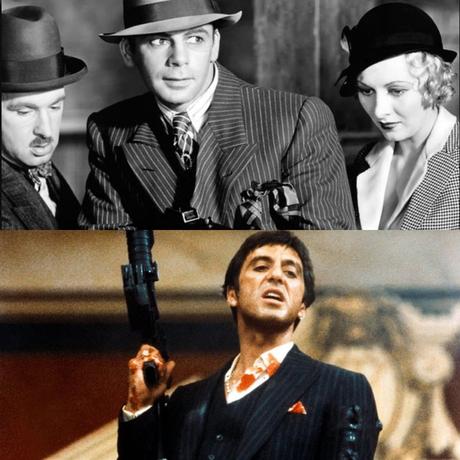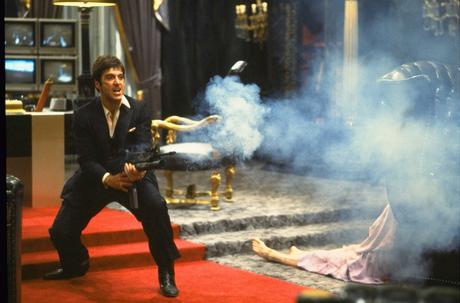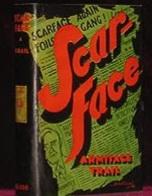
If you were to ask people to name a movie about a gangster, you’d very likely get a lot of responses about Scarface. For a lot of people, they’d be thinking of the 1983 movie starring Al Pacino, but the 1932 version starring Paul Muni was also very influential. Both movies were based on the 1930 book Scarface by Armitage Trail, which was inspired by the life of Al Capone. So how do these movies compare to the original book?
Book & Movie Differences
Neither the 1932 or the 1983 version of Scarface is a particularly faithful book-to-film adaptation. The version starting Paul Muni is a very loose adaptation of the book and the version starting Al Pacino is more of an updated remake of the Paul Muni movie than a new adaptation of the book.
The overall story of Tony is significantly different in the book compared to what we see in either movie. (Tony’s last name is Guarino in the book, Camonte in the 1932 movie, and Montana in the 1983 movie.) The book starts out with Tony as an ambitious young punk with his sights set on the showgirl girlfriend of a big shot gangster. At first, she turns down Tony’s advances, but he eventually convinces her to start seeing him. When the big shot gangster finds out about this, Tony shoots him to death, which ends up being his first big step in establishing himself as a player in the local underworld. When World War I begins, he enlists in the military — not out of any sense of patriotism, but because it was a way for him to evade the police. While in the military, he gains experience with automatic weapons and some of the skills that served him well in the underworld served him well as a soldier. He also gets his distinctive facial scar during the war.
When Tony returns from the war, he’s surprised to learn that the local news had reported he died in combat. Since the scar on his face has made him unrecognizable, even to people he knew, he decides to keep up the impression that he had died and starts working his way up in the underworld under a new name. He’s a very ruthless gangster — always eager for action and gets restless if he thinks things are too quiet in the mob. Eventually, he becomes a gang leader, thriving in prohibition-era Chicago before his inevitable downfall.
Given how different Tony’s story is in the book from either movie, it’s easier to list the things all three versions have in common: the main character’s name is Tony, he’s a ruthless criminal who loves automatic weapons, and has a scar on his face. He’s part of an immigrant family, he kills someone for getting too close to his sister and there’s a big confrontation with police at the end.

Since there so many differences between the various versions of Scarface, let’s just focus on a few key points, starting with Tony’s relationship with his family. One of the most notable aspects of both movies is that Tony has an unhealthy fixation on his sister Cesca, played by Ann Dvorak in the 1932 movie/Gina, played by Mary Elizabeth Mastrantonio in the 1983 movie. While that fixation is in the book version, Tony’s sister is out of the picture until fairly late in the book. Instead, the book focuses more on Tony’s brother, who works his way up in the police force while Tony works his way up as a criminal. The brother is completely left out of both movies. As for Tony’s mother, both movies show her actively rejecting her son’s lifestyle. In the book, Tony’s mother does get financial support from her son, but she doesn’t realize it. Since his family thinks Tony is dead, he figures out a way to send her money under the guise of it being an inheritance from a distant relative.
While the 1983 version of Scarface is mostly a modernized take on the 1932 movie, it does touch on some things from the book that the 1932 movie doesn’t. The Paul Muni version shows Tony becoming fascinated with machine guns when a rival gang uses them on him rather than being introduced to them in the military. In the Al Pacino version, there’s a scene where Manny and Tony are asked if they have experience with machine guns and Manny answers yes, adding that they had been in the Army. The only mention the 1932 movie makes to Tony’s service in the war was as an explanation of where his scar had come from.

The book also makes it very clear that Tony kept some law enforcement officials on his payroll for protection. The 1932 version of Scarface was very controversial for a multitude of reasons and faced many issues with censorship, which likely explains why that version of the movie does not show law enforcement cooperating with the mob. However, the 1983 version does include a scene where Tony and a detective meet in a nightclub and discuss the kind of protection the detective can offer for a price.
One thing we don’t see in the Paul Muni version is what motivates Tony to get into a life of crime rather than pursuing a more legitimate career. The book explains that Tony’s parents tried to establish themselves in America and played by the rules, but it was a struggle for them to get anywhere. So Tony decides that if he’s going to make something of himself, he’s not going to bother playing by the rules. This is closer to what we see in the Al Pacino movie, where Tony realizes pretty quickly that working in a restaurant isn’t going to get him what he wants out of life and starts going after bigger drug-related jobs.
Both versions of the movie feature signs that read “The World is Yours,” which carries a special meaning to Tony. Despite this being a very famous part of both movies, it’s not something that exists in the original book.
Is the Book Worth Reading?

It goes without saying that Scarface is one of the most quintessential gangster stories of all time. However, this is a case where I like both versions of the movie better than the book. Even though there are a lot of differences between both movies and the source material, those changes work in favor of the movies. The parts about Tony letting people think he had died in the war and his own family members not recognizing him when they saw him were just too far fetched for me. It’s also hard not to be a bit blindsided when Tony’s sister enters into the book, because the fact that Tony has any siblings at all aside from his brother had been so very briefly mentioned before that point.
Both versions of the movie took the best aspects of the book and turned them into two something very memorable. But if you’re a big fan of either movie, or of gangster movies in general, I’d still say it’s worth giving the book a shot. It’s a quick and easy read, so if you want to check it out for the sake of getting a better understanding of the movie’s history or its place in the gangster film genre, it at least doesn’t require a big time commitment.
This review is part of the 2023 Classic Film Summer Reading Challenge hosted by Out of the Past. For more reviews on books related to classic film, be sure to follow the #ClassicFilmReading hashtag on social media.
